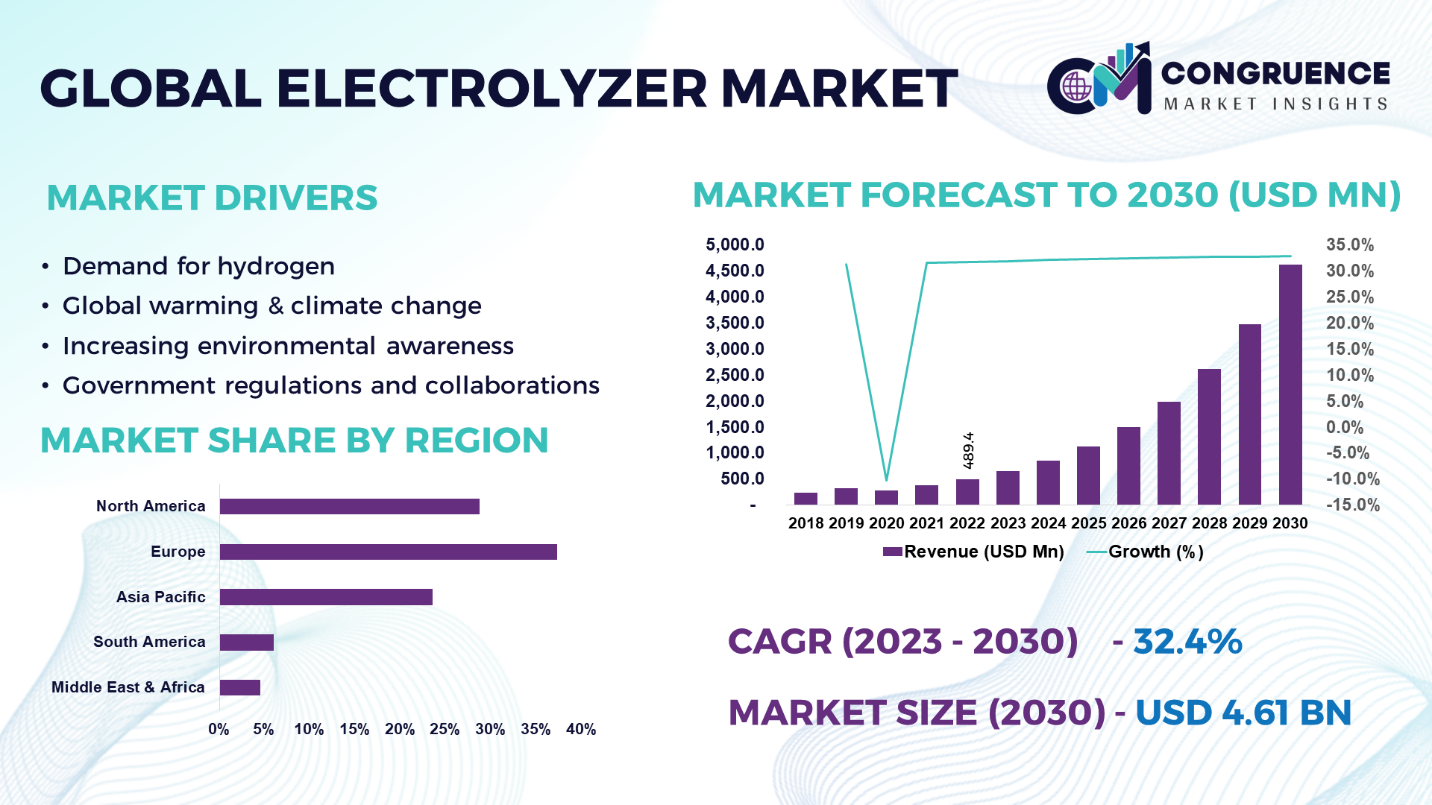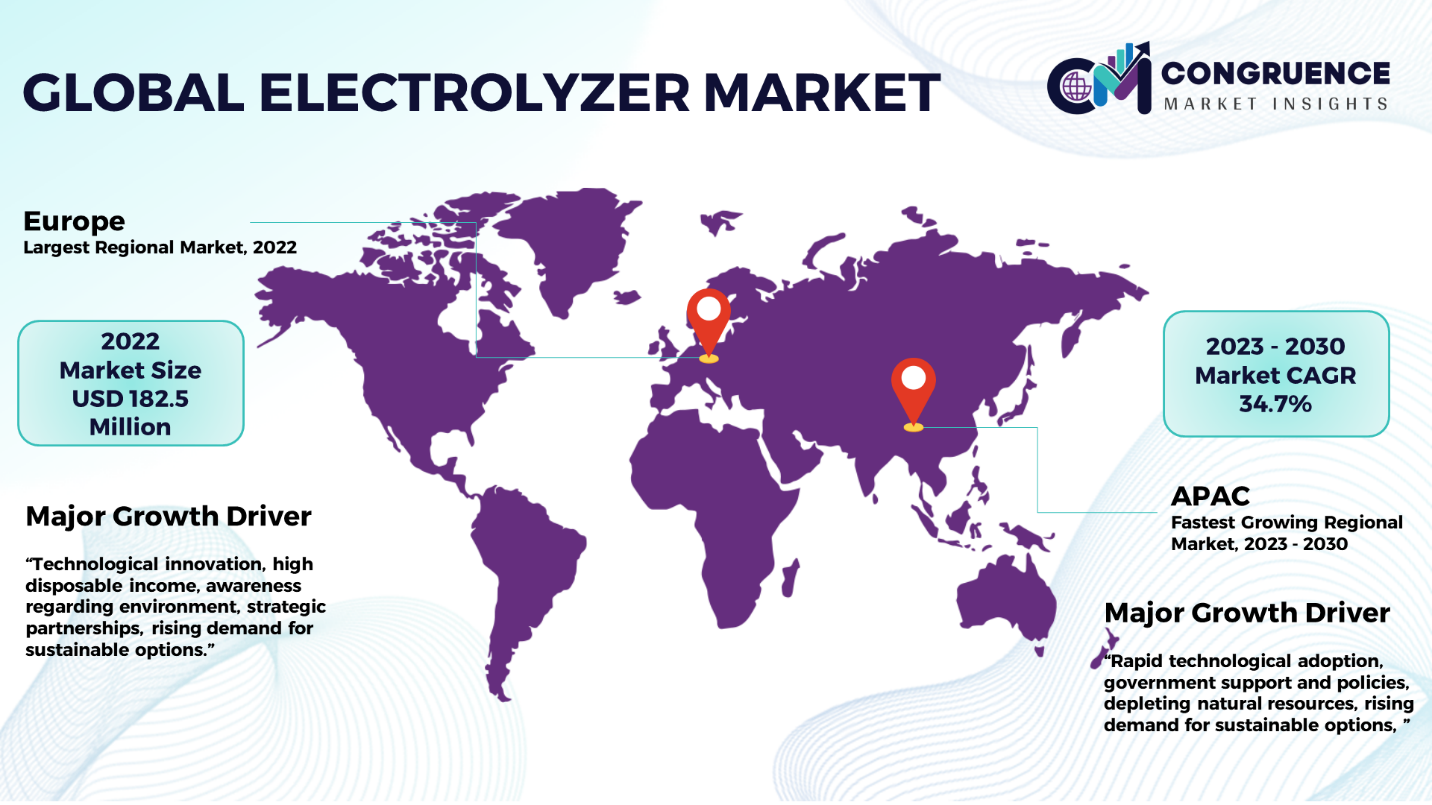Reports
The Global Electrolyzer Market was valued at USD 489.4 Million in 2022 and is anticipated to reach a value of USD 4,606.4 Million by 2030 expanding at a CAGR of 32.4% between 2023 and 2030.
Producing low-emission hydrogen from nuclear or renewable energy sources requires the use of an electrolyzer, a device that uses electricity to separate hydrogen and oxygen molecules through electrolysis. The oxygen that is produced concurrently is released into the atmosphere. It can be preserved in certain conditions to be used as a gas for industrial or medicinal uses at a later time. Hydrogen can be used in hydrogen fuel cells, which can power trains, ships, and airplanes, or it can be liquefied and stored as a gas. It is also used in a variety of sectors. Electrolysis is utilized in many different sectors and is also used to extract and purify metals. Electrolysis processes are employed in one of the commercial methods for producing hydrogen gas. One of the main alternatives for producing hydrogen is electrolysis. Depending on the electrical source used, hydrogen electrolysis may not result in any greenhouse gas emissions.

Electrolyzer Market Major Driving Forces
Demand for Hydrogen: Significant investments have been made in the hydrogen manufacturing business, with big users coming from Malaysia, India, and Singapore. These areas are concentrated on producing and storing more hydrogen, and the expansion in this sector is aided by the transportation sector. The demand for systems for producing and storing hydrogen is predicted to rise further, suggesting that the hydrogen industry has a bright future.
Global Warming & Climate Change: Methane, nitrous oxide, and carbon dioxide are among the greenhouse gases released by conventional automobiles that run on fossil fuels. The primary factor causing both climate change and global warming is greenhouse gas emissions. Vehicles that run on hydrogen fuel produce water as a byproduct, which makes them a significant contributor to the fight against climate change and global warming. Since hydrogen is produced using electrolyzers, this is essentially driving the market.
Increasing Environmental Awareness: There is a greater awareness and drive among the public to reduce carbon emissions since global warming and climate change have reached a point where they are impacting both human and animal life. Consequently, propelling the electrolyzer industry for the production of hydrogen.
Government Regulations and Collaborations: Globally governments and organizations are making investments in electrolyzer technology in order to lower greenhouse gas emissions and produce green hydrogen. The growth of the electrolyzer market is being aided by funding programs, incentives, and supportive government regulations as well as partnerships between business participants and academic institutions.
Electrolyzer Market Key Opportunities
Eco-Friendly and Sustainable Options: The market for electrolyzers has an opportunity to develop and promote hydrogen-based vehicles in response to the growing demand for environmentally friendly fuel. Manufacturers have the opportunity to profit from this trend by producing hydrogen-powered vehicles, which will benefit both the producers of automobiles and electrolyzers.
Fuel Cell Vehicles (FCVs): Transportation-related vehicles such as buses, trucks, trains, maritime vessels, and unmanned aerial vehicles are propelled by hydrogen that is stored in fuel cells. There are fuel cell vehicles (FCVs) available in South Korea, Japan, the United States, and Germany. The commercial FCVs produced by companies such as Hyundai, Toyota, and Honda are propelling the expansion of the electrolyzer market. The capacity to carry goods and services is being revolutionized by this hydrogen-based transportation technology.
Technological developments: Current research enhances electrolyzer systems, lowering prices and increasing scalability, durability, and efficiency. These developments spur market expansion and draw investments.
Electrolyzer market Key Trends
· In an effort to lower carbon emissions across multiple industries, there is a growing need for green hydrogen, which is generated from renewable energy sources.
· Growing economies are investing in renewable energy infrastructure since they understand how electrolyzers and green hydrogen may contribute to sustainable development.
· Continuous research lowers costs and increases the scalability, durability, and efficiency of electrolyzer systems.
· Incorporating electrolyzers into solar and wind power facilities can solve the problems of intermittent power supply and grid balancing by storing and transforming excess renewable energy into hydrogen.
· The need for electrolyzers is rising, which benefits the organizations that produce them by opening up prospects for efficient supply chains and manufacturing capacities.
Region-wise Market Insights
Europe accounted for the largest market share at 37.3% in 2022 whereas, Asia Pacific is expected to register the fastest growth, expanding at a CAGR of 34.7% between 2023 and 2030.

The region known as North America is composed of nations such as the US and Canada. This region has made large investments in hydrogen infrastructure, placed a great deal of focus on clean energy initiatives, and has supportive government policies that encourage the use of electrolyzer technology to further decarbonization efforts. The demand for electrolyzers in North America is rising as a result of all these factors. Europe is the region that includes all of the European countries when discussing the electrolyzer market. The market for electrolyzers in Europe is expected to increase significantly in the next years due to decarbonization efforts, favorable government regulations, and rising investments in renewable energy. Europe wants to lead the world in green hydrogen production and electrolyzer technologies. Asia-Pacific, which includes nations in Oceania, South Asia, and East Asia, is an area where the electrolyzer market is expanding significantly. The increasing need for green hydrogen to enable clean energy transitions and meet carbon reduction targets, along with government initiatives and infrastructure investments in renewable energy, are driving the development in the region.
Segment-wise Market Analysis
· Transportation: Using hydrogen as a clean fuel for automobiles such as cars, trucks, buses, and trains is referred to as transportation in the electrolyzer sector. The use of hydrogen produced by electrolyzers in fuel cell vehicles is becoming more and more popular in the transportation industry. The need to lower carbon emissions in the transportation sector is addressed in part by these cars, which provide mobility that is emissions-free.
· Industry Energy: Hydrogen produced by electrolyzers is used as a clean energy source for industrial operations. The energy trend in industry is a move away from fossil fuels and toward hydrogen-based processes like fuel cells and hydrogen combustion. This shift encourages ecologically friendly practices across a range of businesses and contributes to the reduction of greenhouse gas emissions.
Market Competition Landscape
In the fiercely competitive worldwide electrolyzer market, there are many producers and merchants. These businesses use a variety of tactics to compete in the market, including collaborations, mergers and acquisitions, and product innovation. Their market expansion is demonstrated by the major contracts they receive for the deployment of their electrolyzer systems. These advancements demonstrate the industry's evolution and the major players' dedication to furthering electrolyzer technology.
In order to make a name for themselves, a number of new competitors have entered the electrolyzer market by utilizing innovation and development techniques. They have increased their product offerings, made investments in cutting-edge electrolyzer technology, and concentrated on enhancing scalability and efficiency. However, the established businesses hold a sizable portion of the market due to their extensive experience, robust distribution networks, solid clientele, and continuous investment in R&D. By delivering a large selection of electrolyzer solutions and thorough after-sales support and service, they establish themselves as the industry's reliable leaders and continue to preserve their dominance.
Prominent players in the market include:
· Nel ASA
· Hydrogenics Corporation
· ITM Power PLC
· McPhy Energy S.A.
· Siemens AG
· Proton OnSite
· Giner ELX
· Areva H2Gen
· Tianjin Mainland Hydrogen Equipment Co., Ltd.
· Enapter AG
|
Report Attribute/Metric |
Details |
|
Market Revenue in 2022 |
USD 489.4 Million |
|
Market Revenue in 2030 |
USD 4,606.4 Million |
|
CAGR (2023 – 2030) |
32.4% |
|
Base Year |
2022 |
|
Forecast Period |
2023 – 2030 |
|
Historical Data |
2018 to 2022 |
|
Forecast Unit |
Value (US$ Mn) |
|
Key Report Deliverable |
Revenue Forecast, Growth Trends, Market Dynamics, Segmental Overview, Regional and Country-wise Analysis, Competition Landscape |
|
Segments Covered |
· By Product (Alkaline Electrolyzer, PEM Electrolyzer, Solid Oxide Electrolyzer) · By Capacity (Less than 500 kW, 500 kW to 2 MW, Above 2 MW) · By Application (Power Generation, Transportation, Industry Energy, Industry Feedstock, Building Heat & Power, Others) |
|
Geographies Covered |
North America: U.S., Canada and Mexico Europe: Germany, France, U.K., Italy, Spain, and Rest of Europe Asia Pacific: China, India, Japan, South Korea, Southeast Asia, and Rest of Asia Pacific South America: Brazil, Argentina, and Rest of Latin America Middle East & Africa: GCC Countries, South Africa, and Rest of Middle East & Africa |
|
Key Players Analyzed |
Nel ASA, Hydrogenics Corporation, ITM Power PLC, McPhy Energy S.A., Siemens AG, Proton OnSite, Giner ELX, Areva H2Gen, Tianjin Mainland Hydrogen Equipment Co. Ltd., Enapter AG |
|
Customization & Pricing |
Available on Request (10% Customization is Free) |
